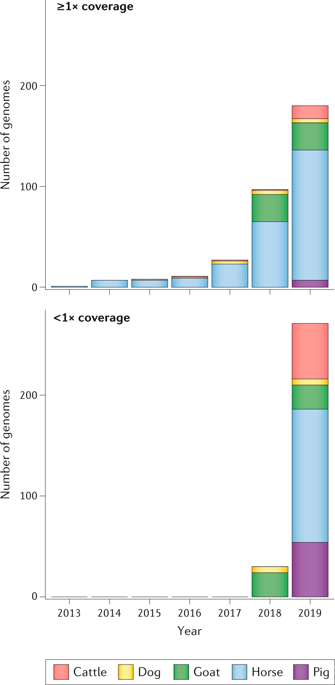当前位置:
X-MOL 学术
›
Nat. Rev. Genet.
›
论文详情
Our official English website, www.x-mol.net, welcomes your
feedback! (Note: you will need to create a separate account there.)
Animal domestication in the era of ancient genomics.
Nature Reviews Genetics ( IF 39.1 ) Pub Date : 2020-04-07 , DOI: 10.1038/s41576-020-0225-0 Laurent A F Frantz 1 , Daniel G Bradley 2 , Greger Larson 3 , Ludovic Orlando 4, 5
Nature Reviews Genetics ( IF 39.1 ) Pub Date : 2020-04-07 , DOI: 10.1038/s41576-020-0225-0 Laurent A F Frantz 1 , Daniel G Bradley 2 , Greger Larson 3 , Ludovic Orlando 4, 5
Affiliation

|
The domestication of animals led to a major shift in human subsistence patterns, from a hunter-gatherer to a sedentary agricultural lifestyle, which ultimately resulted in the development of complex societies. Over the past 15,000 years, the phenotype and genotype of multiple animal species, such as dogs, pigs, sheep, goats, cattle and horses, have been substantially altered during their adaptation to the human niche. Recent methodological innovations, such as improved ancient DNA extraction methods and next-generation sequencing, have enabled the sequencing of whole ancient genomes. These genomes have helped reconstruct the process by which animals entered into domestic relationships with humans and were subjected to novel selection pressures. Here, we discuss and update key concepts in animal domestication in light of recent contributions from ancient genomics.
中文翻译:

古代基因组学时代的动物驯化。
动物的驯化导致人类生存模式发生重大转变,从狩猎采集者转变为久坐不动的农业生活方式,最终导致复杂社会的发展。在过去的 15,000 年中,狗、猪、绵羊、山羊、牛和马等多种动物的表型和基因型在适应人类生态位的过程中发生了重大变化。最近的方法创新,例如改进的古代 DNA 提取方法和下一代测序,使整个古代基因组的测序成为可能。这些基因组帮助重建了动物与人类建立家庭关系并承受新的选择压力的过程。这里,
更新日期:2020-04-07
中文翻译:

古代基因组学时代的动物驯化。
动物的驯化导致人类生存模式发生重大转变,从狩猎采集者转变为久坐不动的农业生活方式,最终导致复杂社会的发展。在过去的 15,000 年中,狗、猪、绵羊、山羊、牛和马等多种动物的表型和基因型在适应人类生态位的过程中发生了重大变化。最近的方法创新,例如改进的古代 DNA 提取方法和下一代测序,使整个古代基因组的测序成为可能。这些基因组帮助重建了动物与人类建立家庭关系并承受新的选择压力的过程。这里,











































 京公网安备 11010802027423号
京公网安备 11010802027423号